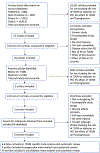Type 2 Diabetes as a Determinant of Parkinson's Disease Risk and Progression
- PMID: 33682937
- PMCID: PMC9017318
- DOI: 10.1002/mds.28551
Type 2 Diabetes as a Determinant of Parkinson's Disease Risk and Progression
Abstract
Background: Type 2 diabetes (T2DM) and Parkinson's disease (PD) are prevalent diseases that affect an aging population. Previous systematic reviews and meta-analyses have explored the relationship between diabetes and the risk of PD, but the results have been conflicting.
Objective: The objective was to investigate T2DM as a determinant of PD through a meta-analysis of observational and genetic summary data.
Methods: A systematic review and meta-analysis of observational studies was undertaken by searching 6 databases. We selected the highest-quality studies investigating the association of T2DM with PD risk and progression. We then used Mendelian randomization (MR) to investigate the causal effects of genetic liability toward T2DM on PD risk and progression, using summary data derived from genome-wide association studies.
Results: In the observational part of the study, pooled effect estimates showed that T2DM was associated with an increased risk of PD (odds ratio [OR] 1.21, 95% confidence interval [CI] 1.07-1.36), and there was some evidence that T2DM was associated with faster progression of motor symptoms (standardized mean difference [SMD] 0.55, 95% CI 0.39-0.72) and cognitive decline (SMD -0.92, 95% CI -1.50 to -0.34). Using MR, we found supportive evidence for a causal effect of diabetes on PD risk (inverse-variance weighted method [IVW] OR 1.08, 95% CI 1.02-1.14; P = 0.010) and some evidence of an effect on motor progression (IVW OR 1.10, 95% CI 1.01-1.20; P = 0.032) but not on cognitive progression.
Conclusions: Using meta-analyses of traditional observational studies and genetic data, we observed convincing evidence for an effect of T2DM on PD risk and new evidence to support a role in PD progression. © 2021 The Authors. Movement Disorders published by Wiley Periodicals LLC on behalf of International Parkinson and Movement Disorder Society.
Keywords: Parkinson's disease; type 2 diabetes.
© 2021 The Authors. Movement Disorders published by Wiley Periodicals LLC on behalf of International Parkinson and Movement Disorder Society.
Conflict of interest statement
Figures




References
-
- Athauda D, Foltynie T. Insulin resistance and Parkinson’s disease: a new target for disease modification? Prog Neurobiol 2016;145–146: 98–120. - PubMed
-
- Szendroedi J, Phielix E, Roden M. The role of mitochondria in insulin resistance and type 2 diabetes mellitus. Nat Rev Endocrinol 2011;8(2):92–103. - PubMed
Publication types
MeSH terms
Grants and funding
LinkOut - more resources
Full Text Sources
Other Literature Sources
Medical

